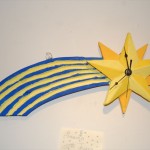We may receive a commission when you use our affiliate links. However, this does not impact our recommendations.
 Early this morning, I dove into my tool chest to pull the stuff I’ll need next week at The Woodwright’s School for a 17th-century joint stool class with Peter Follansbee. And I realized, as I arrayed the tools on my bench, that my bad habits had caught up with me.
Early this morning, I dove into my tool chest to pull the stuff I’ll need next week at The Woodwright’s School for a 17th-century joint stool class with Peter Follansbee. And I realized, as I arrayed the tools on my bench, that my bad habits had caught up with me.
How many of you hone your plane blades and chisels after every use, before you put them away? Yeah; me either. So, I spent more than an hour at our sharpening station putting a mirror polish and sharp edge on five plane blades, six chisels and my marking knife (the knife wasn’t in dire need of a touch-up, but I already had swarf under my nails, so why not?). By the time I finished, I had two acute spots of pain – one on each of my middle fingers (of which I was going to post a picture, but it seemed rude to flip off all our readers).
I did, however, get to spend some quality time with a new set of Japanese ceramic waterstones, the Sigma Select II (which we got from toolsfromjapan.com). These stones, which are designed to sharpen high speed steel and other tough alloys, worked quickly to hone a wicked sharp edge on all my blades (which are a mix of O1, A2 and whatever my Japanese chisels are – wish I knew!). In fact, by the third plane blade (I started with the plane blades), I realized I was making a couple fewer passes on each of the four grits I used (#1,000, #3,000, #6,000 and #10,000) than I used to on our Shaptons.
You do, however, have to factor in soaking time (during which I checked my e-mail) – but I’ve read in several places that these stones can be stored in water with no adverse effects. So when I was finished, I flattened them all with a diamond plate, cleaned out my Tupperware container, filled it with clean water, and plopped the stones back in. (Yes, I made sure they were clean; no, they are not touching one another; no cross-grit contamination for me, thanks.)
The Sigmas quickly break down to form a mess of thick slurry, but at 78mm thick, I expect they’d last a good while in the typical home shop. There are no binders in these stones, nothing but fresh abrasive is released with every pass – I guess that’s one reason why they put an edge on a blade so quickly. But it also means you should flatten them regularly (that’s a good habit I actually do have).
Do I still prefer the Shaptons? Well, yeah – less fuss, less mess. But, if these Sigmas truly don’t break down in water, then I’ll be able to get more sharpening done more quickly, and get back to work. (Prices range from about $65-$100 from coarse to fine.)
If you want sharp tools, want to know what sharp actually means, and want to understand all these newfangled steels (as well as the old ones) you need Ron Hock’s book ‘The Perfect Edge.”
Here are some supplies and tools we find essential in our everyday work around the shop. We may receive a commission from sales referred by our links; however, we have carefully selected these products for their usefulness and quality.









I use the 1000/4000/8000 Shapton GlassStones. On the 4000 and 8000 I rarely make more than eight total strokes per blade per stone, and on the 1000 average only a little more, maybe twelve. I spend more time mounting the blade in the honing guide and making sure it’s square, and flattening the stones afterward, that I do actually honing…
Of course, I do try to sharpen at the first signs of blade distress.
-Steve
Is that a Japanese chisel in the photo?
***swoon***
Luv da Shapton’s , mon!!